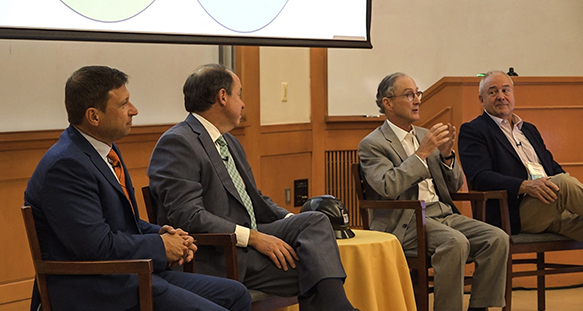From rising labor and energy costs to an aging population whose demand for medical services is expected to surge in the coming years, health care leaders agree that the system must prepare for a set of unprecedented challenges.

“More hospitals in the United States have closed over the last year than in any year in the last decade,” said Chief Medical Officer, Dr. Richard P. Shannon, senior vice president and chief quality officer at Duke Health. “This is a really precarious moment.”
Shannon joined Dr. Michael Schlosser, senior vice president of Care Transformation and Innovation at HCA and Dr. James Merlino, executive vice president and chief innovation officer at The Joint Commission to discuss solutions to these multiple challenges in an opening panel for the 17th Health Care Design & Construction Symposium, hosted by the School of Engineering’s Department of Civil and Environmental Engineering. The event took place August 9-10 and included an audience of more than 100 leaders and speakers in health care administration, construction, planning and design.

“This annual event offers those working in all aspects of the planning and development of healthcare facilities key insights into that rapidly evolving industry,” said Sanjiv Gokhale, Engineering Endowed Director of Construction Management and professor of the practice of civil engineering. “Each year our conference garners more interest from those working in health care who want to make a positive and lasting impact on the built environment of our health care system. Vanderbilt’s School of Engineering offers an ideal setting for those discussions to take place.”
As physicians and health care industry leaders, panel members presented examples of company efforts through the lens of symposium’s three topics—social, environmental and economic sustainability—to a mixed audience of health care professionals, facility designers, project managers, construction engineers, architects and contractors.
Dependence on health care workers, especially nurses, became “front and center” during the pandemic. “There’s an unbreakable relationship between having the workforce we need to take care of patients and keeping our doors open,” said Schlosser. HCA operates 186 hospitals and more than 2,000 sites of care in the U.S. He said hospitals also are facing staff challenges in acute care, anesthesia, radiology and hospital-based physician pools, as well.
HCA trains 5,500 residents a year and two years ago created a care transformation and innovation team to redesign care delivery to eliminate some administrative burden and identify other efficiencies.
Another solution is to think differently about how groups of professionals are empowered, Merlino said. “Medicine is a tiered legacy practice. Only doctors can do certain things. Only nurses can do certain things, only aides can do certain things. Take some of the responsibilities that maybe doctors don’t need to do. Push them to the nurses. Likewise, take some away from nurses, push it to the aides. For example, there’s a body of evidence that suggests nurse practitioners and nurses are better at managing some chronic disease conditions than doctors.”
Hospitals and care facilities will have to adapt to the aging population and the trend of longer lifetimes. “More nursing care will be needed to adapt to that population outside and inside the hospital, which is going to become more acute,” Merlino said. “Hospitals today are becoming almost all intensive care units.”
“I am not an engineer by background, but I do try to play one every day in my role,” said Shannon. “The solution rests in redesigning the work of the health care deliverers, and that is about re-engineering work processes.” At Duke, lean management principles are used to eliminate time waste, improve workflow and performance.
The speakers agreed that solutions are evolving about the contribution of principles of environmental sustainability can make to improving health care and caring for the environment. Duke is going through an assessment of its greenhouse gas emissions using scope 1, 2 and 3 emission categories, not unlike other industries.
Strides are being made to reduce or better manage high energy use, medical waste, as well as causes of greenhouse gases, such as inhalational anesthetics, getting rid of test fluorine, and processes of sterilization and infection prevention. “It’s the right thing that we should be doing as an industry,” Merlino said.
The pandemic also brought economic sustainability into sharp focus. The workforce exited during the pandemic, but they’re not gone, Schlosser said. For nurses no longer interested in being at the bedside, there are many who are willing to work from home. “We’ve tapped into that with virtual nursing. They can beam into a room and do an admission assessment and discharge education. That allows us to tap into a workforce that otherwise we wouldn’t have had access to.”
The panelists acknowledged that the economic environment for providers is challenging due to inflation, labor and supply costs, capacity constraints and more. “Everyone’s looking to point the finger somewhere. We’re trying to double down on people development and productivity, growth and quality, and we have not made the progress we need to make in reducing waste,” Shannon said.
To the design and construction attendees Shannon said, “Patient ‘flow and pull’ allow you not to have waiting rooms, but how much of our clinic buildings are consumed in these? You know, where you get to watch ESPN while you wait? I’d rather watch it at home.
“I just have one ask and that is next time you sit down with a health care person and they’re asking you to design waiting rooms into the plan, refuse,” Shannon said. “Waiting rooms are the quintessential example of waste.”
Featured speakers at two-day included Dr. Richard J. Liekweg, president and CEO, BJC HealthCare; John F. Manning, COO and chief of staff, Vanderbilt University Medical Center; Kevin Mahoney, CEO, University of Pennsylvania Health System; Dr. Elizabeth Baca, managing director, Deloitte; and Michelle Mader, managing director, Ankura.
Contact: brenda.ellis@vanderbilt.edu